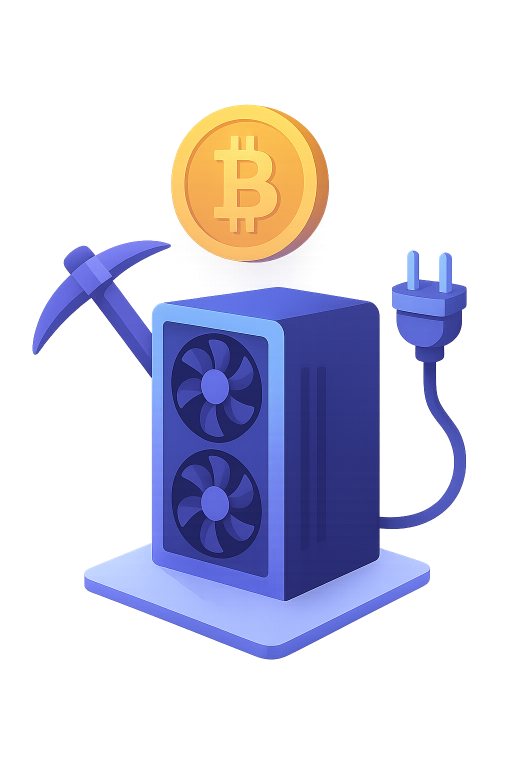Crypto Mining
Earn Crypto Through Proof-of-Work in 2025
Intro | Types | Guide | Opportunities | FAQs

Introduction
What Is Crypto Mining?
Cryptocurrency mining using a Proof-of-Work (PoW) consensus mechanism is the original method of earning crypto as passive income. It involves using computing hardware to solve complex puzzles, thereby validating transactions and securing networks like Bitcoin and Ethereum Classic. Miners compete to add new blocks to the blockchain, and each successful miner earns a block reward in cryptocurrency (plus transaction fees) as an incentive. This category page will guide beginners through PoW mining with their own hardware (ASIC rigs or GPU rigs), covering what PoW is, how it works, required equipment, and strategies for profitability. (Note: Cloud mining – renting mining power remotely – is not covered here; see our Cloud Mining page for that.) In the broader crypto passive income landscape, PoW mining stands alongside other strategies like staking (Proof-of-Stake), masternodes, and yield farming – but PoW mining offers the unique appeal of directly supporting decentralized networks through computational work.
What Is Proof-of-Work Mining?
Proof-of-Work mining is a consensus mechanism where decentralized participants (miners) expend computational effort to validate transactions and secure the blockchain. In PoW networks, miners’ computers race to solve a cryptographic puzzle (finding a hash below a target value) that proves a certain amount of work was done. This process ensures security by making it costly in terms of energy and hardware to attempt malicious changes.
Network Security: PoW mining underpins major cryptocurrencies like Bitcoin and Ethereum Classic. These networks rely on miners to secure the ledger – the high cost of computing power and electricity needed to beat honest miners deters attacks. For example, Bitcoin’s PoW mechanism continuously adjusts the difficulty of the puzzle so that a new block is mined roughly every 10 minutes, maintaining network stability and resisting manipulation. Ethereum Classic similarly continues to use PoW to remain decentralized and secure after the original Ethereum moved to Proof-of-Stake.
Miner Rewards: The incentive for miners is passive income in the form of cryptocurrency rewards. When a miner successfully mines a block, they receive a block reward (a fixed number of new coins) plus all transaction fees in that block. For instance, Bitcoin miners currently earn 3.125 BTC per block (after the 2024 halving) in addition to the fees users paid for transactions in that block. These rewards are earned automatically by the mining software when a block is solved, making PoW mining an attractive (though competitive) passive income model for those with the proper setup.
In summary: PoW mining is the process of using computing power to earn crypto by maintaining the blockchain. Next, we’ll break down exactly how mining works and what you need to get started.
How Mining Works
Under PoW, mining a cryptocurrency like Bitcoin involves a competitive race to solve a mathematical puzzle. Below is a step-by-step breakdown of how the mining process works:
- Collecting Transactions: Miners assemble a candidate block of the latest pending transactions from the network’s mempool. These transactions will be verified and added to the blockchain if the block is successfully mined.
- Assembling the Block Header: The miner constructs a block header containing important metadata – including a reference to the previous block’s hash, a Merkle root of the current block’s transactions, a timestamp, and a special random number called a nonce.
- Proof-of-Work Puzzle (Hashing): Using mining software, the miner’s hardware repeatedly hashes the block header (running it through the coin’s hash algorithm, e.g. SHA-256 for Bitcoin) with different nonce values. Each hash output is a large number. The goal is to find an output number that is below a target threshold set by the network (this target makes the puzzle hard).
- Difficulty Target & Nonce: The network’s difficulty setting determines how small this target hash value is – the lower the target, the harder it is to find a hash below it. Miners effectively play a guessing game: try a nonce, compute the hash, and check if the result is a “winning” hash. If not, change the nonce and hash again. This can require trillions of attempts across the whole network before someone finds a valid hash.
- Finding a Valid Hash: Eventually, one miner’s machine finds a nonce that produces a hash meeting the difficulty target (i.e., a hash with the required number of leading zeros). This miner solves the PoW puzzle and has proof that they expended the necessary computational work.
- Broadcasting and Verification: The winning miner broadcasts their block (with the solution hash) to the network. Other nodes quickly verify the proof-of-work – which is easy to check – and confirm that all transactions in the block are valid. Once verified, the block is added to the blockchain.
- Block Reward & Fees: The successful miner now earns the block reward plus all included fees. The reward is automatically assigned to the miner’s wallet via a special coinbase transaction in the block. For example, a Bitcoin miner would receive the BTC reward in their Bitcoin wallet address configured in the mining software.
- Difficulty Adjustment: The network periodically adjusts difficulty to keep block production constant as computing power changes. For instance, Bitcoin recalibrates its difficulty every 2016 blocks (~ every 2 weeks) so that if blocks were coming too fast (because many miners joined), the puzzle gets harder, and if blocks slowed (miners left), the puzzle gets easier. This ensures a stable issuance rate and is why mining grows more challenging in favorable conditions.
In essence, mining is like a lottery where buying more “tickets” (hash attempts) increases your chances of winning a block. Next, we’ll discuss the hardware that generates those hash attempts: specialized mining rigs and their requirements.
Benefits of PoW Mining
Mining isn’t just about profit—it offers various advantages for participants:
- Passive Income Stream: Once set up, rigs earn 24/7 with minimal intervention. Rewards accumulate automatically, providing steady income.
- Predictable Rewards: Fixed schedules (e.g., Bitcoin block every 10 minutes) offer consistency, especially in pools.
- Control Over Hardware (Self-Sovereignty): Own your setup and coins—no third-party reliance. Flexible coin switching if using GPUs.
- Supporting Decentralization: Contribute to network security and censorship-resistance, aligning with crypto principles.
Learning and Innovation: Gain hands-on knowledge of hardware and blockchain; spurs tech advancements like efficient cooling.
While mining has perks, understand the risks next.
Risks of PoW Mining
Proof-of-Work mining, while potentially rewarding, comes with challenges and risks:
- High Upfront Costs: Equipment like ASICs ($ thousands) requires big investment; longer ROI if unprofitable.
- Hardware Obsolescence: New models make old ones inefficient; resale value drops.
- Increasing Difficulty & Competition: More miners raise difficulty, shrinking rewards.
- Electricity Costs & Energy Consumption: Power bills dominate; fluctuations hurt profits. Heat/noise disrupt home setups.
- Market Volatility: Coin price drops turn mining loss-making; hold or sell strategically.
- Regulatory and Legal Risks: Bans, taxes, or tariffs vary by region; monitor laws.
- Other Challenges: Theft risk, downtime from failures, opportunity cost vs. holding crypto.
Successful miners manage these with planning and diversification.
EXPLORE
Types of Mining Hardware
Not all computers are suited for profitable mining. Over the years, mining hardware has evolved from normal CPUs to specialized machines. The two main types of hardware used today for PoW mining are ASIC miners and GPU-based mining rigs. Each has its pros and cons:
ASIC Miners (Application-Specific Integrated Circuits)
ASIC miners are purpose-built devices designed to do one thing extremely efficiently: compute hashes for a specific PoW algorithm. For example, a Bitcoin ASIC is custom-built to perform SHA-256 hashing at high speed. ASICs are orders of magnitude more powerful than general-purpose hardware – the most powerful Bitcoin ASICs can compute >400 terahashes per second (TH/s), whereas a high-end GPU might manage ~120 megahashes per second (MH/s) on a similar algorithm. This huge gap means ASICs dominate mining on any network where they are available.
Pros: ASICs offer unmatched hash power and efficiency. They perform hashing far faster and with lower energy per hash than GPUs or CPUs. This makes them more cost-effective for mining major PoW coins. ASIC rigs are typically plug-and-play and come in a fixed form factor, often including built-in controllers and fans.
Cons: The downside is lack of versatility and high cost. ASICs can only mine the algorithm they’re built for (e.g., a SHA-256 ASIC can mine Bitcoin or other SHA-256 coins, but cannot mine Ethash coins). If a coin changes its algorithm or becomes unprofitable, the ASIC has little to no alternative use. Additionally, ASIC hardware can be expensive (often thousands of dollars per unit), creating high upfront capital requirements. They also tend to have shorter lifespans in terms of profitability – as newer, more efficient models release, older ASICs quickly become obsolete (their hashpower may no longer justify their electricity usage). Physically, ASIC miners are loud and hot. Many produce 70+ decibels of noise and significant heat output, which makes them ill-suited for living spaces. Running an ASIC at home often requires a garage, basement, or warehouse with dedicated cooling and ventilation. They also draw high power (often 1–3 kW each); setting up multiple ASICs might require electrical upgrades to handle the load safely.
Use Cases: ASICs are used for major PoW cryptocurrencies that attract enough value to warrant specialized hardware. Bitcoin is the prime example (mined almost exclusively with ASICs). Others include Litecoin (Scrypt ASICs), Bitcoin Cash (SHA-256 like BTC), Dash (X11 ASICs), and Ethereum Classic (which still uses Ethash – now ASICs exist for Ethash as well). If you plan to mine one of these ASIC-friendly coins, investing in a quality ASIC miner is generally the only viable path to meaningful passive income. As of July 2025, top models include Bitmain Antminer S21 Pro (200 TH/s at 17.5 J/TH) and MicroBT Whatsminer M60S (186 TH/s at 19.9 J/TH).
GPU Mining Rigs (Graphics Processing Units)
GPU mining uses consumer or professional graphics cards (GPUs) to mine cryptocurrency. A GPU is a versatile processor capable of handling the parallel computations needed for many PoW algorithms (especially those designed to be ASIC-resistant). Miners build “rigs” with multiple GPUs working in tandem to increase hashpower. GPUs excel at mining certain altcoins – for example, before Ethereum’s move to PoS, GPUs were widely used to mine ETH. Today, GPUs target coins like Ravencoin, Ethereum Classic, Ergo, Kaspa and others that can still be mined effectively without ASICs.
Pros: GPU rigs are flexible and multi-purpose. A set of GPUs can mine a variety of algorithms; if one coin becomes unprofitable, you can switch your GPUs to another coin with a different algorithm. This flexibility hedges against changes in mining markets. GPUs are also readily available and have resale value – if you stop mining, the cards can be sold or repurposed (e.g., for gaming or AI tasks). For beginners, starting with a single GPU or a small rig can be more accessible and lower-cost than buying an ASIC. GPU mining is also generally quieter and easier to cool on a small scale (though large GPU farms will still generate heat).
Cons: The hashpower of GPUs, compared to ASICs, is significantly lower for the same algorithms. This means GPUs cannot profitably mine coins where ASICs exist – for example, mining Bitcoin with a GPU is futile, as an ASIC is tens of thousands of times more efficient. GPU mining is typically only profitable on smaller networks or those deliberately resistant to ASICs. Moreover, a powerful GPU like an Nvidia RTX 4090 costs ~$1,600+ and might only achieve around 250 MH/s on Ethash (or a few GH/s on other algos), which is trivial next to an ASIC’s terahashes. Thus, profit margins on GPU mining can be thin, especially after Ethereum’s transition removed the most lucrative GPU coin. Also, building and maintaining multi-GPU rigs can be technical: one must manage drivers, overclocking, and sometimes deal with hardware crashes or troubleshooting each component. Also, GPUs still consume substantial power (a rig of 6–8 cards can easily draw over 1 kW), so electricity cost and heat output remain considerations, though on a lesser scale than ASIC farms.
Use Cases: GPU mining is suitable for smaller coins and hobby mining. It’s often the entry point for new miners to learn the ropes. Coins like Ethereum Classic (ETC), Monero (which is actually CPU-friendly), Ravencoin (KAWPow), Flux, and others have communities of GPU miners. GPU rigs can also be used for speculative mining – mining new coins that have no ASICs yet, hoping their value increases. Keep in mind that the GPU mining landscape can change quickly; profitability should be checked on a mining calculator and hardware should ideally serve dual purposes or have resale value to mitigate risk. As of July 2025, top GPUs for mining include NVIDIA GeForce RTX 4090 (high hash for KawPow ~120 MH/s ETC) and AMD RX 7900 XTX.
In summary: ASICs offer raw power for top coins but are costly and single-purpose, while GPUs offer versatility and lower entry cost but much less hashpower. Next, the infrastructure needed to run these.

LEARN
How to Start Mining
Ready to mine? Follow these steps for a small setup:
-
Choose Which Cryptocurrency to Mine
Select PoW coins like Bitcoin (ASIC) or ETC/Ravencoin (GPU). Use WhatToMine for profitability.
-
Acquire the Mining Hardware
Buy ASICs (e.g., Antminer S21 Pro) for BTC or GPUs (e.g., RTX 4090) for alts. Start small.
-
Set Up a Crypto Wallet
Use secure wallets like Ledger for rewards. Configure payout address.
-
Prepare Your Mining Rig
Assemble hardware, ensure power/cooling, connect Ethernet.
-
Install and Configure Mining Software
Use Braiins OS+ for ASICs or Hive OS for rigs. Join pool, input wallet.
-
Start Mining and Monitor
Launch software, check hash rate/temp. Use alerts.
-
Optimize and Tweak Settings
Overclock for efficiency; test stability.
-
Track Your Earnings
Use pool dashboard; calculate profits vs. costs.
-
Secure and Manage Rewards
Transfer to cold wallet; decide hold/sell.
-
Expand or Upgrade
Reinvest profits if profitable.
Mining Setup Requirements
Mining isn’t just about hardware—a successful operation requires proper infrastructure and environment. Whether you’re running a single rig at home or planning a mining farm, consider the following setup requirements:
-
Power Supply & Electrical
Ensure adequate electrical capacity and a reliable power source. Mining rigs draw significant wattage (one ASIC can use 2,000+ watts; a multi-GPU rig easily 1,000+ watts). For home setups, spread rigs across circuits or upgrade your breaker. Use high-quality PSUs for GPU rigs. Tip: Measure consumption with a power meter—e.g., a 2000 W miner at $0.10/kWh costs $4.80 daily.
-
Cooling & Ventilation
Mining generates heat. Place rigs in well-ventilated areas and use fans or AC. ASICs run hot (70+ dB noise); GPUs are quieter but still need airflow. Dust clogs cooling, so clean regularly. Some repurpose heat for home warming.
-
Location & Space
Choose dry, cool, secure spaces. Home: Garage or basement to minimize noise. Industrial: Warehouses with cooling. Ensure support for weight and minimal dust.
-
Internet Connection
Stable connection for pool communication. Bandwidth is low, but uptime matters—use Ethernet for reliability. Backup if scaling up.
-
Mining Software & Pools
Install software like CGMiner for ASICs or LolMiner for GPUs. Join pools for consistent payouts (e.g., Slush Pool for BTC). Configure with pool URL and wallet address.
-
Monitoring & Maintenance
Use dashboards for uptime, temp, hash rate. Set alerts; clean dust, replace fans as needed.
By covering power, cooling, location, connectivity, and software, you create a stable foundation for mining. Next, the factors affecting profitability.
Profitability Factors
Mining profitability balances income (earned coins) against expenses (electricity, hardware). Here are the key factors:
-
Hash Rate (Mining Power)
Speed of hashes (e.g., TH/s for ASICs). Higher rate = larger reward share. Network hash rate percentage determines earnings.
-
Mining Difficulty
Adjusts puzzle hardness based on total hash rate. Rising difficulty reduces individual rewards. Monitor trends—spikes can turn profits negative.
-
Block Rewards & Emissions
Coins per block (e.g., 3.125 BTC). Halvings reduce rewards; account for future changes in calculations.
-
Cryptocurrency Market Price
Rewards in crypto—price drops cut fiat value. Break-even price is key; hedge if possible.
-
Electricity Cost
Largest expense. Lower rates boost profits. Calculate daily: (Wattage × 24 ÷ 1000) × kWh rate.
-
Hardware Costs & Depreciation
Upfront investment; ROI estimates payback time. New models obsolete old ones—factor resale value.
-
Other Expenses
Pool fees (1-2%), maintenance, cooling. Subtract from revenue for true profit.
Use calculators like WhatToMine for estimates. Profitable mining needs efficient hardware and low costs.
Mining Strategies & Models
No one-size-fits-all in mining—choose based on resources:
-
Solo Mining
Mine alone for full rewards. Pros: No fees. Cons: Rare payouts; impractical for small setups.
-
Pool Mining
Join others for shared rewards. Pros: Consistent income. Cons: 1-2% fees. Recommended for most.
-
Home Mining vs. Mining Farm
Home: DIY, convenient for small rigs. Farm: Scalable, cheap power locations. Start home, scale if profitable.
-
Cloud Mining
Rent hashpower remotely. Pros: No hardware hassle. Cons: Risks like scams; see our Cloud Mining page.
Hybrid: Switch coins or mix solo/pool. Adapt to markets.
Monitor
Real-Time Mining Opportunities
On July 2025, here’s live mining profitability for popular PoW coins (estimates for 1 TH/s ASIC or 100 MH/s GPU; $0.10/kWh power). Use calculators for your setup.
| Coin | Hardware |
Daily Profit
| Notes |
|---|---|---|---|
|
Bitcoin (BTC)
|
ASIC (S21 Pro)
|
$0.50-$2.00
|
High difficulty; 3.125 BTC reward.
|
|
Ethereum Classic (ETC)
|
GPU (RTX 4090)
|
$0.20-$0.80
|
~0.429 ETC daily; GPU-friendly.
|
|
Litecoin (LTC)
| ASIC (Antminer L7) | $1.00-$3.00 |
Merge-mined with DOGE; Scrypt algo.
|
|
Monero (XMR)
|
GPU/CPU
|
$0.10-$0.50
|
Privacy coin; RandomX ASIC-resistant.
|
| Ravencoin (RVN) |
GPU (RTX 4090)
|
$0.15-$0.60
|
KawPow; asset creation focus.
|
Data from WhatToMine/Minerstat; verify and adjust for your costs.
Understand
How We Review and Rank Mining Platforms

Hash Power & Performance
Actual vs. advertised hash rate; consistency.

Energy Efficiency
J/TH or J/GH—lower is better for costs.

Cost & Pricing
Value per hash; ROI estimates.

Reliability and Warranty
Build quality, lifespan, support.

Hosting & Facilities
For cloud/hosting—uptime, infrastructure.

User Experience & Customer Support
Ease of setup, monitoring.

Transparency and Trustworthiness
Operations, history, audits.
Clarify
FAQs About PoW Mining
Is cryptocurrency mining still profitable in 2025?
Yes, but it depends on coin, electricity costs, and hardware. Bitcoin’s high difficulty squeezes small miners, but efficient ASICs and cheap power can yield profits. Do the math—bull markets boost returns.
Can I mine Bitcoin or other cryptos from home, or do I need a warehouse?
You can mine at home with 1-2 ASICs or GPUs in a garage/basement, handling noise and heat. Warehouses suit large setups for scalability.
What’s the best ASIC miner right now?
As of July 2025, Bitmain Antminer S21 Pro (200 TH/s, 17.5 J/TH) or MicroBT Whatsminer M60S (186 TH/s, 19.9 J/TH) top lists for efficiency.
How do I manage the risks of mining?
Start small, calculate ROI, optimize electricity, monitor updates, secure hardware/wallets, and diversify coins. Join communities for tips.
What are the maintenance requirements for mining rigs? Do I need to check them often?
Daily monitoring for temp/hash rate; weekly dust cleaning; replace fans/paste yearly. Smart alerts help—it’s manageable with routine.
What should I do with the coins I mine? Hold or sell?
Hold if bullish on price; sell for costs if needing cash flow. Hybrid: Cover expenses, hold rest. Taxes apply on receipt/sale.
Glossary of Mining Terms
- ASIC (Application-Specific Integrated Circuit): Specialized hardware for one algorithm, like SHA-256 for Bitcoin; high efficiency but inflexible.
- GPU (Graphics Processing Unit): Versatile card for mining multiple coins; good for beginners but less powerful than ASICs.
- Hash Rate (Hash Power): Computations per second (e.g., TH/s); higher means more rewards.
- Nonce: Variable miners change to find valid hashes.
- Difficulty: Network value making puzzles harder; rises with competition.
- Block Reward: Coins for mining a block (e.g., 3.125 BTC).
- Transaction Fees: User-paid fees miners collect.
- Pool & Share: Group mining; shares prove work for proportional rewards.
- Merge Mining: Mining two coins simultaneously (e.g., LTC/DOGE).
- J/TH (Joules per Terahash): Energy efficiency; lower = better.
- ROI (Return on Investment): Time to recover costs; estimate payback.
- Halving: Reward reduction (e.g., Bitcoin every 4 years).
Tools & Resources for Miners
-
- Mining Profitability Calculators: WhatToMine or CoinWarz for daily estimates.
- Mining Pools: Slush Pool for BTC, Ethermine for ETC, ViaBTC for LTC/DOGE.
- Firmware & Software: Braiins OS+ for ASICs, Hive OS for rigs.
- Hardware Shopping: Bitmain/Antminer.com for ASICs, TechPowerUp for GPUs.
- Community: r/BitcoinMining, Bitcointalk.org, YouTube (VoskCoin).
- Our Resources: Mining Hardware Reviews, Cloud Mining, Glossary.
Happy mining! Explore our Passive Income Categories for more.
